We may earn revenue from the products available on this page and participate in affiliate programs. Learn More ›
Refrigerators are likely used more than almost any other major appliance in the home, except perhaps for the heating and cooling system. With such frequency of use, it’s important to invest in a durable, energy-efficient fridge from a reliable brand to preserve your food at the safest temperature.
To narrow the field when you shop for the best refrigerator, use this guide to learn more about today’s top-quality brands. You’ll gain insight into why consumers trust these kitchen appliance manufacturers, what their products are known for, and how their versatile food storage options, innovative features, and attractive designs may function in your kitchen.
We’ve gathered our Top Picks from each of the best refrigerator brands to help you buy a refrigerator that might suit your family’s needs.
1. KitchenAid

Price Range: $$ to $$$$
Our Top Picks: KitchenAid French Door Refrigerator for $3,799.99; KitchenAid 27 Cu. Ft. French Door Refrigerator for $2,599.97; or KitchenAid French Door Counter-Depth Refrigerator for $4,199.99.
In business for more than a century, KitchenAid is an appliance brand that is known for refrigerators and several other kitchen appliances that have a range of versatile options. Owned by the Whirlpool Corporation, KitchenAid is based in the U.S., which keeps shipping and repair costs down for American consumers. Due to KitchenAid’s affiliation with Whirlpool and its extensive range of products, this brand can offer a wide assortment of sizes, styles, and features unavailable in some smaller brands.
While its advanced products sit at the high end of the affordability scale, most KitchenAid refrigerators are midrange models with modest prices that have the durability and reliability of top-end models. Both the original and counter-depth French door refrigerators provide value for the money with their Preserva Food Care System that lets you independently control the temperatures of the fresh and freezer compartments. Both models include a built-in ice and water dispenser as well.
Shop KitchenAid refrigerators at Lowe’s, The Home Depot, or Best Buy.
2. LG
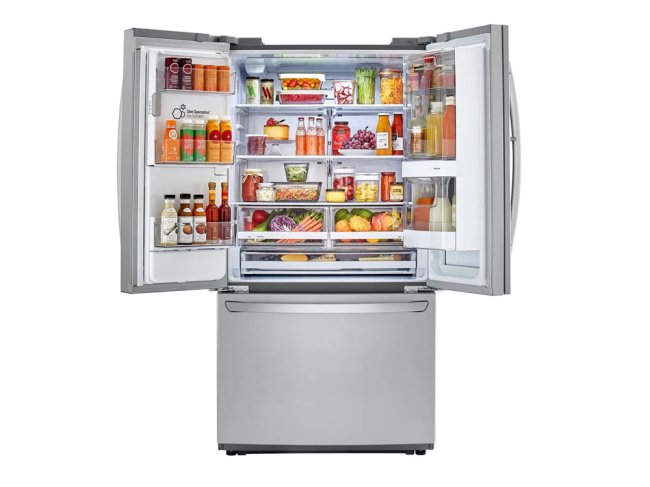
Price Range: $$ to $$$
Our Top Picks: LG Counter-Depth Refrigerator with Craft Ice for $2,999.99; or LG Top-Freezer Energy Star Refrigerator for $849.00.
LG is considered a high-end electronics brand, so it’s no surprise that the company’s fridges are known for Wi-Fi and smart-home compatibility. Founded in South Korea in 1958, LG is a household name across America due to its high-quality televisions, computers, and innovative appliances.
Prioritizing innovation over standard functionality, the range of extra features on LG refrigerators can seem a bit daunting at first. Yet some consumers have come to appreciate bells and whistles like voice-activated commands, door-in-door access, and designated door cooling systems to keep items in the doors just as cold as those stored in the main compartments. LG’s three-door French door smart refrigerator, for example, allows you to connect to the refrigerator through Wi-Fi with a smartphone, tablet, or computer to change the temperature or adjust the ice maker settings. Note that these high-tech features do come at a higher cost than more basic models.
Shop LG refrigerators at Lowe’s, The Home Depot, or Best Buy.
3. Frigidaire
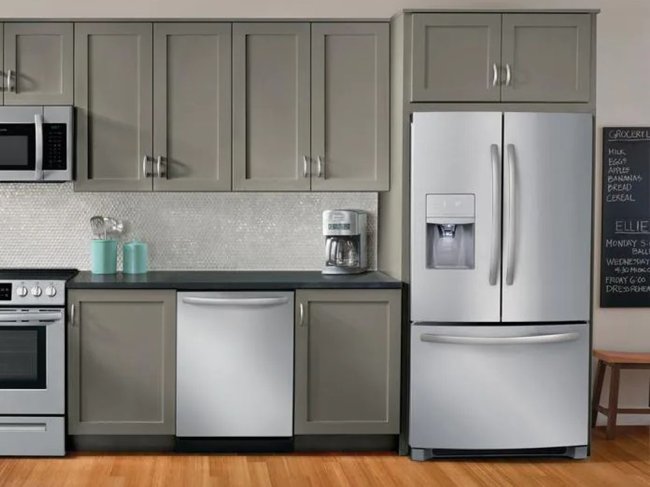
Price Range: $ to $$$
Our Top Picks: Frigidaire French Door Refrigerator for $2,999.00; Frigidaire Mini Fridge for $209.99; or Frigidaire Professional Refrigerator Freezer Combo for $6,922.49.
Now a U.S. subsidiary of Electrolux, Frigidaire has been producing refrigerators for more than 100 years, making it one of the most reliable refrigerator brands available.
Frigidaire produces a wide assortment of refrigerators from basic, budget-friendly models to high-end products with features comparable to those from LG and Samsung (often at lower prices). One of our favorite Frigidaire refrigerators is its high-capacity French door model, which includes a pull-out deep freezer with adjustable storage and a built-in filtration system for pure water that flows directly from the fridge.
Shop Frigidaire refrigerators at Amazon, The Home Depot, Best Buy, or AJ Madison.
4. Whirlpool

Price Range: $ to $$$
Our Top Picks: Whirlpool Bottom Freezer Refrigerator for $1,598.00; Whirlpool Counter Depth Refrigerator for $1,438.00; or Whirlpool 4-Door Refrigerator for $3,099.00.
Since 1955, Whirlpool has been well known for manufacturing a range of energy-efficient refrigerators. The company has nine manufacturing facilities across the U.S. and owns several smaller appliance brands, including KitchenAid, Maytag, and Amana.
Expect to find the Energy Star symbol on most of Whirlpool’s refrigerators due to the company’s focus on producing eco-friendly and sustainable appliances, meeting modern consumer demand. Its bottom freezer refrigerator, for example, is an eco-friendly and energy-efficient pick with a modern design that’ll complement any kitchen. Whirlpool also offers a wide range of sizes and features, as well as easy-to-find replacement parts, making repairs for Whirlpool (and its associated brands) an affordable alternative to replacing the entire fridge.
Shop Whirlpool refrigerators at Lowe’s, The Home Depot, or Best Buy.
5. Samsung
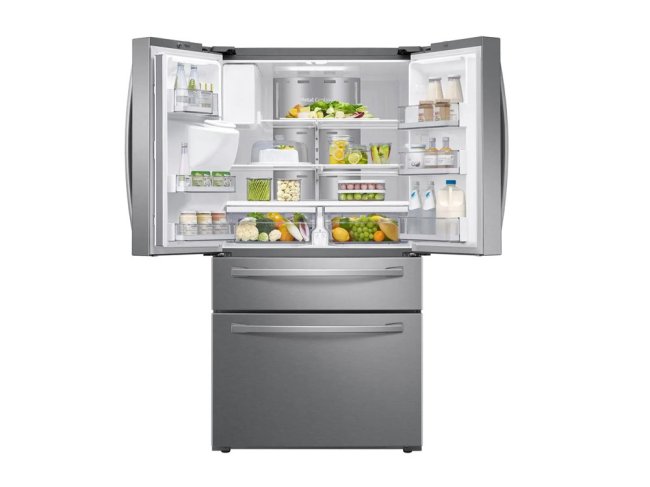
Price Range: $$$ to $$$$
Our Top Picks: Samsung 4-Door Family Hub+ Smart Refrigerator for $4,999.00; Samsung 4-Door Flex French Door Refrigerator for $2,299.99; or Samsung Large-Capacity Side-by-Side Refrigerator for $1,599.00.
Samsung specializes in producing refrigerators with high-quality Wi-Fi and smart-home features that can integrate with mobile devices and smart-home systems. Renowned for producing high-end electronics, it’s currently one of the largest smartphone manufacturers in the world.
Samsung combines innovative technology with reliable appliances, often incorporating features into their refrigerator products like smart-home compatibility, voice commands, remote access, and touch-screen displays—high-tech extras that tend to increase the price tag for their products. One of our favorites is Samsung’s Family Hub+ smart refrigerator, which allows you to play music on Spotify and share pictures thanks to a built-in Family Hub touch screen that serves as a digital bulletin board.
Shop Samsung refrigerators at Amazon, The Home Depot, or Best Buy.
6. GE Appliances
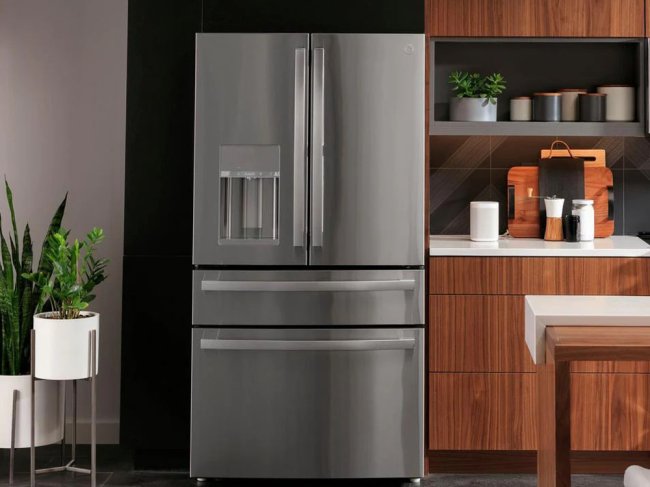
Price Range: $ to $$$$
Our Top Picks: GE Appliances Smart 4-Door French Door Refrigerator for $4,399.00; GE Mini Fridge Double-Door Design for $509.00; or GE Counter-Depth Side-by-Side Refrigerator for $1,2399.00.
After more than a century of experience in electronics and appliances, GE Appliances is still one of the most popular appliance manufacturers in America.
GE makes quality products with a range of sizes and features consistent with current consumer demand, but its hallmark has long been durability—appliances that can stand up to rough use, like doors being yanked open and slammed shut. GE’s Smart four-door French door refrigerator features a durable stainless steel exterior and robust doors, making it ideal for homes where appliances endure considerable wear and tear. The brand’s exteriors are typically resistant to stains and dents, while the hinges are thick and robust, preventing doors from bending or breaking.
Shop GE refrigerators at Amazon, Lowe’s, or The Home Depot.
7. Maytag
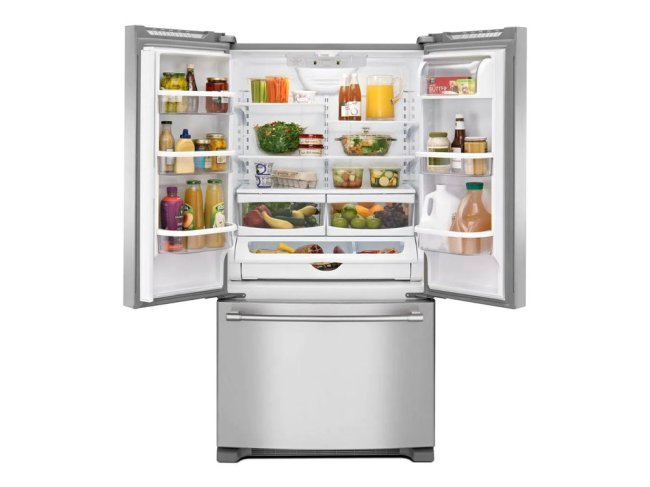
Price Range: $ to $$$
Our Top Picks: Maytag French Door Refrigerator for $2,099.99; Maytag 25 Cu. Ft. Side-by-Side Freestanding Refrigerator for $1,299.99; or Maytag Side-by-Side Refrigerator for $1,648.00.
Big families and overzealous grocery shoppers will appreciate Maytag’s spacious refrigerators.
Now owned by the Whirlpool Corporation, Maytag was founded in 1893 in Newton, Iowa. While some other brands may focus on high-end features and striking visual designs, Maytag focuses on functionality and spaciousness for its refrigerators.
The company’s big fridges can handle a lot, from bulk grocery orders to holiday leftovers. With a total capacity of just under 25 cubic feet, the French door refrigerator is one of our top picks, with a large pull-out freezer, making it ideal for bulk grocery orders. Do keep in mind that the larger the size, the higher the price.
Shop Maytag refrigerators at Lowe’s, The Home Depot, or Best Buy.
8. Café
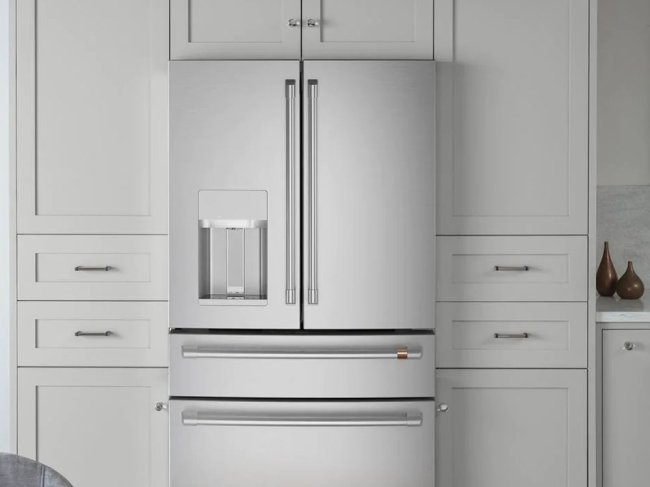
Price Range: $$$ to $$$$
Our Top Picks: Café Smart 4-Door French Door Refrigerator for $4,319.00; Café French Door Refrigerator for $2,879.00; or Café Built-In 2-Drawer Refrigerator for $3,239.00.
A relatively new brand from GE, Café products are made for that portion of the consumer market looking for aesthetic appeal over affordability. Café refrigerators have distinct designs, like LED light walls, which are unique to this brand. The Café Smart French door refrigerator features this LED light wall for maximum interior illumination, as well as hands-free water filling and different humidity levels to keep food fresher for longer.
Most Café products include such premium features as built-in water filtration, smart-home integration, auto water dispensing functions, and proximity lights that illuminate the fridge when someone approaches. Good looks and the latest advancements come with a pretty high price tag, however.
Shop Café refrigerators at Lowe’s, The Home Depot, or Best Buy.
9. Danby

Price Range: $ to $$
Our Top Picks: Danby Designer Freezerless Refrigerator for $784.99; Danby Compact Refrigerator for $299.99; or Danby Beverage Center for $279.99.
Danby makes affordable and compact refrigerators that are well suited to condo and apartment living. Founded in Montreal, Quebec, in 1947, Danby started making hot plates, slow cookers, and an early portable air conditioner. Appliances remain a specialty, and its compact fridges suit one- and two-person apartments and condos.
While they may not have the capacity to hold enough food for the average-size family, Danby fridges often suffice for single people and couples. Danby’s Designer freezerless refrigerator is one of the best small-space investments you can make, with a space-saving design that measures a mere 23.13 inches tall by 10.26 inches wide by 9.43 inches deep and sits flush with most kitchen counters. Due to its models’ compact size, Danby products are typically quite affordable.
Shop Danby refrigerators at Amazon, The Home Depot, or Best Buy.
10. Bosch
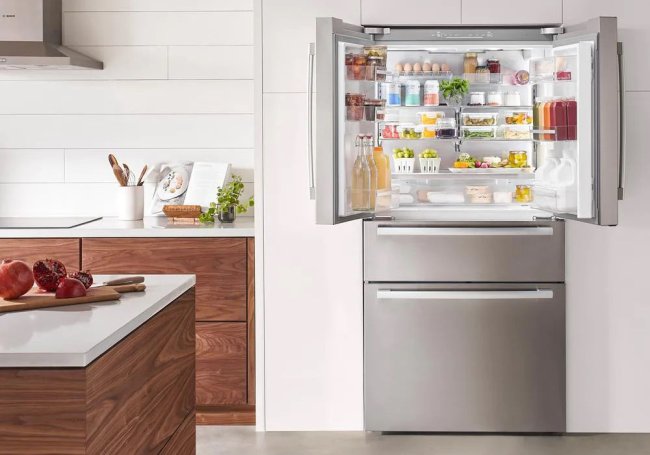
Price Range: $$$ to $$$$
Our Top Picks: Bosch 800 Series Refrigerator for $3,699.00; or Bosch 800 Series Smart Counter Depth French Door Bottom Freezer Refrigerator for $3,499.00.
Bosch is a German appliance company with a reputation for sleek and functional designs that keep food neatly organized. Expect Bosch refrigerators to have adjustable shelves, spacious storage, and multiple compartments, allowing users to customize temperature and organize items to suit individual needs.
A great example of this is Bosch’s 800 Series refrigerator, with a pull-out freezer drawer at the bottom and a drawer in the middle where fruits and vegetables can experience the VitaFresh temperature and humidity control system. The “place-for-everything” design helps consumers who struggle to keep the fridge tidy.
Shop Bosch refrigerators at Lowe’s, The Home Depot, or Best Buy.
11. Haier
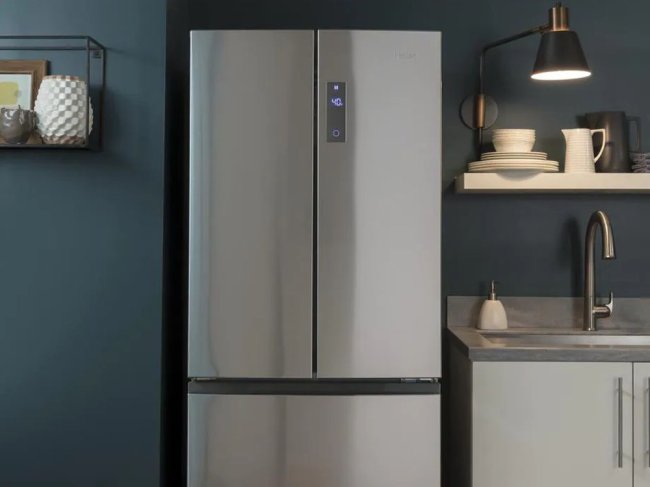
Price Range: $$ to $$$
Our Top Picks: Haier French Door Refrigerator for $1,799.00; Haier Top-Freezer Refrigerator for $611.00; or Haier 16.8 cu. ft. Counter Depth French Door Refrigerator for $1,999.00.
Based in China, Haier was founded in 1984 as the Qingdao Refrigerator Co. The company grew quickly in both popularity and size, eventually acquiring GE’s appliance division in 2016. Through GE, Haier also owns the Café brand of appliances. Despite these acquisitions, Haier also manufactures its brand of refrigerator that tends to have a more basic appearance than brands like Samsung or LG.
Haier refrigerators have clean exteriors and simple interiors that are made for functionality. They lack many of the premium features offered by competitors, but the average user can appreciate the reliable design and the affordable price of these refrigerators. High-efficiency flush-mounted LED lighting, clear door shelves, and freezer drawers are what wait inside Haier’s French door refrigerator. Keep in mind that parts for Haier refrigerators aren’t as easy to find as domestic brands, so repairs can be costly.
Shop Haier refrigerators at Lowe’s, The Home Depot, or Best Buy.
12. Monogram
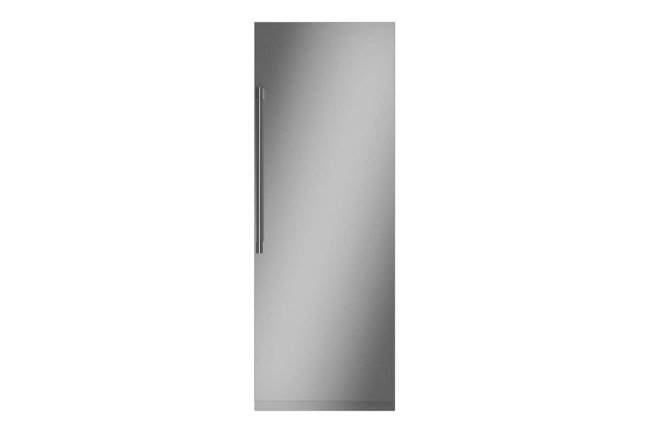
Price Range: $$$ to $$$$
Our Top Picks: Monogram Counter Depth Side-by-Side Refrigerator for $11,500.00; Monogram Professional Column Smart Refrigerator for $8,700.00; or Monogram 36-Inch Panel Ready Built-In Bottom-Freezer Smart Refrigerator for $10,100.00.
Monogram is known as the “ultra-premium” appliance range made by GE at their facility in Louisville, Kentucky. The brand has a reputation for using the best materials, employing precision engineering techniques, and incorporating the latest technology. Monogram builds products without compromise, but as a result, they demand considerable investment.
Sizes range from compact 24-inch under-counter models to high-capacity 48-inch appliances. Exteriors are high-quality stainless steel or custom panels, allowing Monogram refrigerators to blend in with any kitchen style. Monogram’s counter-depth side-by-side refrigerator is a high-capacity appliance with smart control, express chill and defrost functions, and sealed bins for maximum freshness. Interiors feature advanced temperature management, climate control, and convenient touches like a self-closing vegetable drawer and autofill water pitchers.
Shop Monogram refrigerators at Best Buy or AJ Madison.
13. Zline
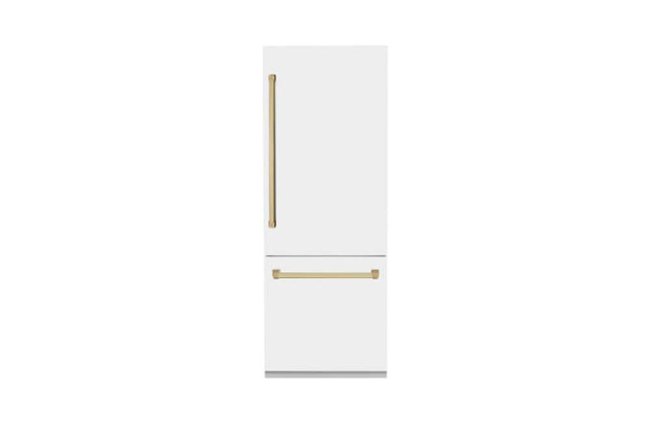
Price Range: $$$ to $$$$
Our Top Picks: Zline 4-Door Counter-Depth Built-In Refrigerator for $12,354.00; Zline Autograph Edition Refrigerator for $7,399.95; or Zline 4-Door Freestanding French Door Refrigerator for $4,999.95.
A U.S.-based family-owned company, Zline portrays itself as an affordable luxury and provides premium-quality refrigerators, most of which focus on high capacity. The company’s commitment to sustainability includes efforts such as reduced packaging, increased recycling, and attaining Energy Star compliance on as many appliances as possible.
The majority of the Zline refrigerators are three- and four-door models with luxurious stainless steel exteriors or panel-ready alternatives. Zline’s four-door freestanding French door refrigerator has a black fingerprint-resistant exterior that is complemented by champagne gold accents. Inside there are multiple cooling zones for precise control of food and beverage temperatures. Pricing is in line with other premium refrigerator brands like Café and Monogram.
Shop Zline refrigerators at Lowe’s, The Home Depot, or AJ Madison.
14. Insignia
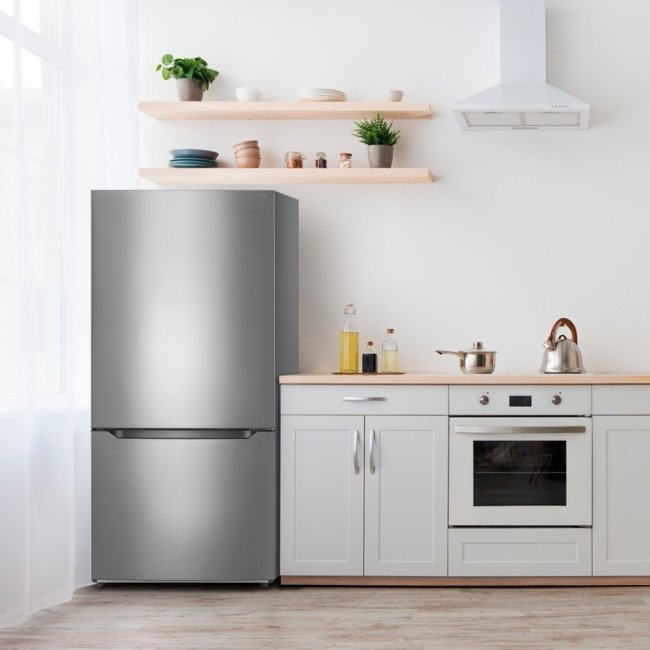
Price Range: $ to $$
Our Top Picks: Insignia Garage-Ready Convertible Upright Refrigerator for $479.99; Insignia Side-by-Side Refrigerator for $929.99; or Insignia Bottom Freezer Refrigerator for $679.99.
Launched by Best Buy in 2005, Insignia initially offered TVs and expanded into refrigerators, freezers, beverage coolers, dishwashers, washers, and dryers. Designs are basic but functional, offering competitive performance at reasonable prices.
Insignia’s garage-ready convertible upright refrigerator can operate as a refrigerator or freezer, with an Energy Star-certified design, easy-to-use touch-sensitive controls, and a door-open alarm. Feature sets on entry-level models can be modest but provide all the essentials. Larger models offer greater temperature control and extras like ice makers while still maintaining budget-friendly prices.
Shop Insignia refrigerators at Best Buy.
How We Chose the Best Refrigerator Brands
After extensive research reviewing the most popular models from the leading refrigerator brands, we narrowed the field from hundreds of refrigerators to this collection of top-quality models using criteria based on performance, aesthetic appeal, intended use, capacity, and configuration.
While the basic function of all refrigerators is the same—keeping food fresh and cool—there are many ways to achieve this objective through material, design, and technology. The models that made this list include refrigerators in a variety of finishes, sizes, door and drawer configurations, and price points. From smart refrigerators to stylish statement-makers to budget-friendly options, the refrigerators that made the Top Products list are some of the best options to meet today’s food storage needs.


